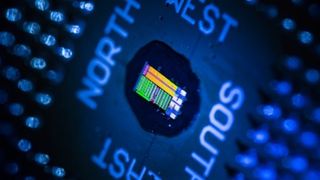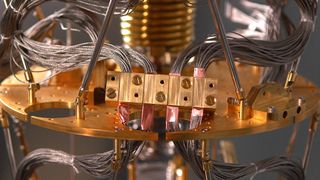Beyond silicon: We discover the processors of your future tech
From stacked CPUs to organic and quantum processing
Go organic
In 2011, researchers in Belgium created a plastic microprocessor by printing 4,000 plastic transistors on flexible plastic foil. It's hardly a Core i7 – it can run one program consisting of 16 instructions – but while it isn't very powerful, it's very cheap. And if research into roll to roll or sheet to sheet printing pays off, it could get cheaper still – processors would be printed using organic 'inks'.
For that to happen, though, we'd need to get much more accurate organic printers – while silicon processors head for single digits in the nanometre scale, lab-scale printing is still working in micrometres. There are issues of variability too, because plastic transistors aren't as predictable as silicon ones.

Should have gone to Specsavers
Maybe the problem isn't the silicon. Maybe it's electricity. One of the most promising alternatives to silicon is to create optical or photonic computers based on light. Unfortunately those computers have to deal with a number of issues. Light doesn't like sharp bends. Optical wires need to be significantly bigger than electronic ones – think 1000 nanometres compared to the 14 nanometres silicon is achieving. And miniaturising optical transistors is tough.
In late 2015, researchers at the University of Colorado-Boulder, MIT and Berkeley made a breakthrough: they combined photonic circuitry and electronic circuitry on a single chip. "It's the first processor that can use light to communicate with the external world," said project lead professor Vladimir Stojanović. "No other processor has photonic I/O in the chip."
The chip achieved a density of 300gb/s, which is up to 10 times better than electrical microprocessors. Once again the prototype isn't very powerful, but it shows a middle way between electrical and photonic circuitry that could bring some form of optical computing to our computers in a fairly short time period.

Quantum break
Last but not least, there's quantum computing. Google's working on it and the first working quantum processor was built at Yale in 2009, but it's exceptionally hard to explain.
Quantum computers aren't binary like traditional ones, where 0 is off and 1 is on. Quantum numbers can exist in multiple states at the same time, which means quantum computers could consider multiple options simultaneously. In a 64-bit quantum computer, each 64-bit register is capable of holding 18,446,744,073,709,551,616 different values at the same time. If you were to carry out some computation, it would therefore be carried out on all those values at once.
Are you a pro? Subscribe to our newsletter
Sign up to the TechRadar Pro newsletter to get all the top news, opinion, features and guidance your business needs to succeed!
There's an astonishing amount of money being spent on quantum computing research by organisations and governments, but for now it remains a far away if rather tantalising possibility.
This article is part of TechRadar's Silicon Week. The world inside of our machines is changing more rapidly than ever, so we're looking to explore everything CPUs, GPUs and all other forms of the most precious metal in computing.
Writer, broadcaster, musician and kitchen gadget obsessive Carrie Marshall has been writing about tech since 1998, contributing sage advice and odd opinions to all kinds of magazines and websites as well as writing more than a dozen books. Her memoir, Carrie Kills A Man, is on sale now and her next book, about pop music, is out in 2025. She is the singer in Glaswegian rock band Unquiet Mind.
Most Popular

